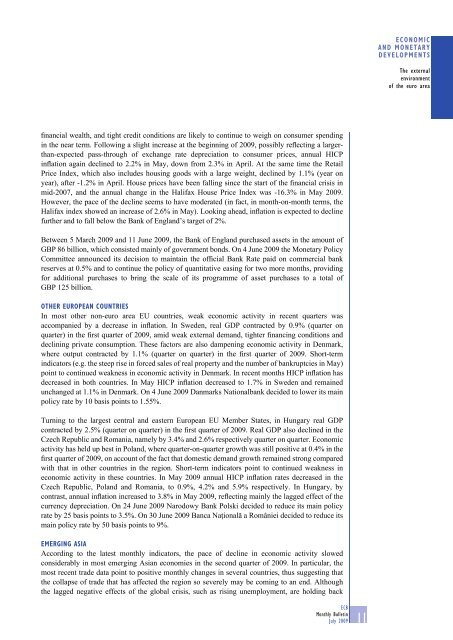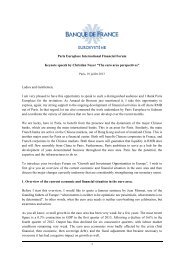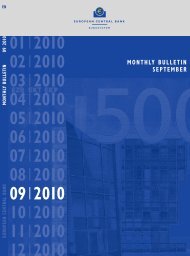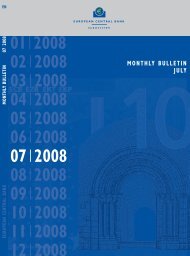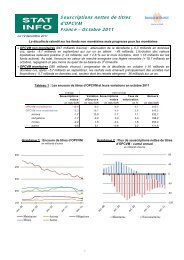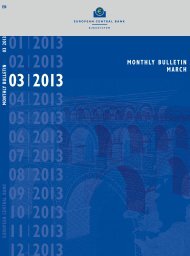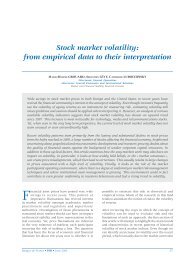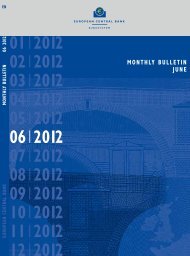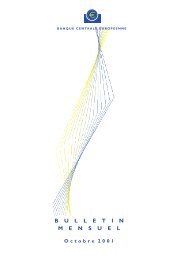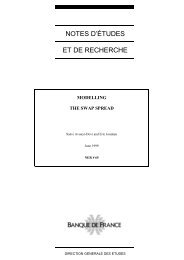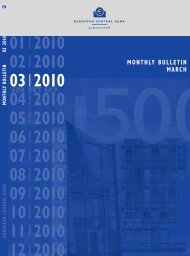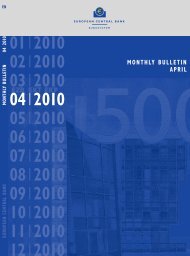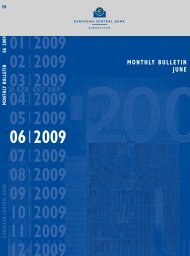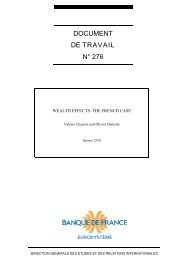Monthly Bulletin July 2009 - Banque de France
Monthly Bulletin July 2009 - Banque de France
Monthly Bulletin July 2009 - Banque de France
Create successful ePaper yourself
Turn your PDF publications into a flip-book with our unique Google optimized e-Paper software.
ECONOMIC<br />
AND MONETARY<br />
DEVELOPMENTS<br />
The external<br />
environment<br />
of the euro area<br />
financial wealth, and tight credit conditions are likely to continue to weigh on consumer spending<br />
in the near term. Following a slight increase at the beginning of <strong>2009</strong>, possibly reflecting a largerthan-expected<br />
pass-through of exchange rate <strong>de</strong>preciation to consumer prices, annual HICP<br />
inflation again <strong>de</strong>clined to 2.2% in May, down from 2.3% in April. At the same time the Retail<br />
Price In<strong>de</strong>x, which also inclu<strong>de</strong>s housing goods with a large weight, <strong>de</strong>clined by 1.1% (year on<br />
year), after -1.2% in April. House prices have been falling since the start of the financial crisis in<br />
mid-2007, and the annual change in the Halifax House Price In<strong>de</strong>x was -16.3% in May <strong>2009</strong>.<br />
However, the pace of the <strong>de</strong>cline seems to have mo<strong>de</strong>rated (in fact, in month-on-month terms, the<br />
Halifax in<strong>de</strong>x showed an increase of 2.6% in May). Looking ahead, inflation is expected to <strong>de</strong>cline<br />
further and to fall below the Bank of England’s target of 2%.<br />
Between 5 March <strong>2009</strong> and 11 June <strong>2009</strong>, the Bank of England purchased assets in the amount of<br />
GBP 86 billion, which consisted mainly of government bonds. On 4 June <strong>2009</strong> the Monetary Policy<br />
Committee announced its <strong>de</strong>cision to maintain the official Bank Rate paid on commercial bank<br />
reserves at 0.5% and to continue the policy of quantitative easing for two more months, providing<br />
for additional purchases to bring the scale of its programme of asset purchases to a total of<br />
GBP 125 billion.<br />
OTHER EUROPEAN COUNTRIES<br />
In most other non-euro area EU countries, weak economic activity in recent quarters was<br />
accompanied by a <strong>de</strong>crease in inflation. In Swe<strong>de</strong>n, real GDP contracted by 0.9% (quarter on<br />
quarter) in the first quarter of <strong>2009</strong>, amid weak external <strong>de</strong>mand, tighter financing conditions and<br />
<strong>de</strong>clining private consumption. These factors are also dampening economic activity in Denmark,<br />
where output contracted by 1.1% (quarter on quarter) in the first quarter of <strong>2009</strong>. Short-term<br />
indicators (e.g. the steep rise in forced sales of real property and the number of bankruptcies in May)<br />
point to continued weakness in economic activity in Denmark. In recent months HICP inflation has<br />
<strong>de</strong>creased in both countries. In May HICP inflation <strong>de</strong>creased to 1.7% in Swe<strong>de</strong>n and remained<br />
unchanged at 1.1% in Denmark. On 4 June <strong>2009</strong> Danmarks Nationalbank <strong>de</strong>ci<strong>de</strong>d to lower its main<br />
policy rate by 10 basis points to 1.55%.<br />
Turning to the largest central and eastern European EU Member States, in Hungary real GDP<br />
contracted by 2.5% (quarter on quarter) in the first quarter of <strong>2009</strong>. Real GDP also <strong>de</strong>clined in the<br />
Czech Republic and Romania, namely by 3.4% and 2.6% respectively quarter on quarter. Economic<br />
activity has held up best in Poland, where quarter-on-quarter growth was still positive at 0.4% in the<br />
first quarter of <strong>2009</strong>, on account of the fact that domestic <strong>de</strong>mand growth remained strong compared<br />
with that in other countries in the region. Short-term indicators point to continued weakness in<br />
economic activity in these countries. In May <strong>2009</strong> annual HICP inflation rates <strong>de</strong>creased in the<br />
Czech Republic, Poland and Romania, to 0.9%, 4.2% and 5.9% respectively. In Hungary, by<br />
contrast, annual inflation increased to 3.8% in May <strong>2009</strong>, reflecting mainly the lagged effect of the<br />
currency <strong>de</strong>preciation. On 24 June <strong>2009</strong> Narodowy Bank Polski <strong>de</strong>ci<strong>de</strong>d to reduce its main policy<br />
rate by 25 basis points to 3.5%. On 30 June <strong>2009</strong> Banca Naţională a României <strong>de</strong>ci<strong>de</strong>d to reduce its<br />
main policy rate by 50 basis points to 9%.<br />
EMERGING ASIA<br />
According to the latest monthly indicators, the pace of <strong>de</strong>cline in economic activity slowed<br />
consi<strong>de</strong>rably in most emerging Asian economies in the second quarter of <strong>2009</strong>. In particular, the<br />
most recent tra<strong>de</strong> data point to positive monthly changes in several countries, thus suggesting that<br />
the collapse of tra<strong>de</strong> that has affected the region so severely may be coming to an end. Although<br />
the lagged negative effects of the global crisis, such as rising unemployment, are holding back<br />
ECB<br />
<strong>Monthly</strong> <strong>Bulletin</strong><br />
<strong>July</strong> <strong>2009</strong><br />
11


